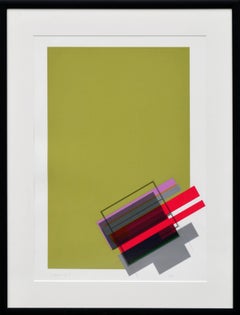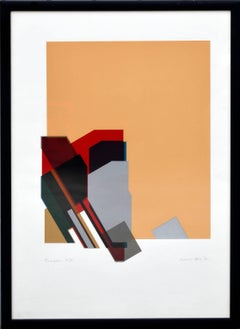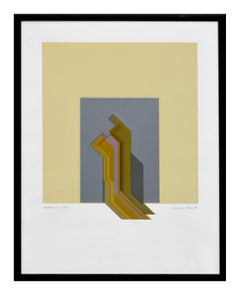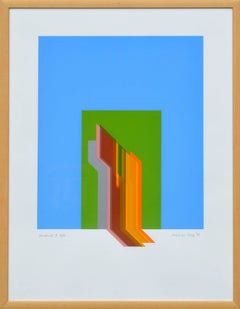Michael Hale On Sale
1980s Color-Field Abstract Prints
Paper, Ink, Screen
1980s Color-Field Abstract Prints
Ink, Screen, Laid Paper
Recent Sales
1980s Abstract Expressionist Abstract Prints
Paper, Ink
1980s Abstract Geometric Abstract Prints
Ink, Paper, Screen
People Also Browsed
1990s Italian Mid-Century Modern Wall Lights and Sconces
Brass
21st Century and Contemporary Swedish Mid-Century Modern Table Lamps
Textile
1950s Abstract Landscape Paintings
Masonite, Oil
Vintage 1980s Italian Modern Picture Frames
Glass, Plexiglass, Lucite, Acrylic, Murano Glass, Art Glass
Vintage 1970s Italian Modern Coat Racks and Stands
Glass, Wood
1970s Abstract Expressionist Figurative Paintings
Paper, Charcoal, Watercolor
2010s Portuguese Minimalist Night Stands
Burl, Poplar
Early 20th Century Swedish Art Deco Cabinets
Birch
20th Century Brazilian Organic Modern Loveseats
Hardwood
Mid-20th Century American Mid-Century Modern Sofas
Upholstery, Wood
1960s Pop Art Abstract Prints
Screen
Vintage 1940s Danish Scandinavian Modern Floor Lamps
Brass
2010s European Organic Modern Western European Rugs
Wool
2010s Oceanic Organic Modern Ottomans and Poufs
Fabric, Foam, Jacquard
1980s Contemporary Landscape Paintings
Canvas, Oil
1970s Abstract Geometric Abstract Prints
Screen
Michael Hale for sale on 1stDibs
In 1957, commercial screenprinter Chris Prater and his wife Rose set up their own business in a tiny space in Kentish Town: Kelpra Studios. Within the period of a decade, they had introduced a mind-boggling array of Britain’s greatest artists to the medium of screenprinting. Like the Wizard of Oz orchestrating proceedings from behind his curtain, Prater collaborated with them all to the highest degree, succeeding — virtually single-handedly as it is now recognized — in elevating the medium to an accepted art form within the eyes of even our most traditional institutions. Early converts included Eduardo Paolozzi and Richard Hamilton, the latter instigating the Institute of Contemporary Arts (ICA) sponsorship and exhibition of a portfolio of prints in 1964. The 24 artists who were introduced to screenprinting as a result included Gillian Ayres, Patrick Caulfield, Peter Blake, Bernard Cohen, Robyn Denny, David Hockney, Howard Hodgkin, Allen Jones, R.B. Kitaj, Victor Pasmore, Peter Phillips, Bridget Riley and William Turnbull. These artists (and many more, including John Piper, who became a long-term acolyte), continued to collaborate with Prater and incorporated screenprinting fully into their oeuvre, producing works equally as important, acclaimed and collectible as their paintings.
In 1980 the Praters gifted their collection of printer’s proofs (a copy of every print they had ever worked on) to Tate, securing their legacy for the enjoyment of the public and ensuring that this fascinating and important chapter in the history of British art would not be forgotten. Mike Hale could perhaps be considered something of a "lost" figure within this movement. Hale was, nonetheless, a pioneering screenprinter. And indeed, he worked as a master printing technician at Kelpra Studios for a time, before going on to teach at the Leicester College of Art where his meticulous approach influenced a new generation of artists working in the medium which, by the early 1960s, had exploded in popularity.
Finding the Right Abstract-prints-works-on-paper for You
Explore a vast range of abstract prints on 1stDibs to find a piece to enhance your existing collection or transform a space.
Unlike figurative paintings and other figurative art, which focuses on realism and representational perspectives, abstract art concentrates on visual interpretation. An artist may use a single color or simple geometric forms to create a world of depth. Printmaking has a rich history of abstraction. Through materials like stone, metal, wood and wax, an image can be transferred from one surface to another.
During the 19th century, iconic artists, including Edvard Munch, Paul Cézanne, Georgiana Houghton and others, began exploring works based on shapes and colors. This was a departure from the academic conventions of European painting and would influence the rise of 20th-century abstraction and its pioneers, like Pablo Picasso and Piet Mondrian.
Some leaders of European abstraction, including Franz Kline, were influenced by the gestural shapes of East Asian calligraphy. Calligraphy interprets poetry, songs, symbols or other means of storytelling into art, from works on paper in Japan to elements of Islamic architecture.
Bold, daring and expressive, abstract art is constantly evolving and dazzling viewers. And entire genres have blossomed from it, such as Color Field painting and Minimalism.
The collection of abstract art prints on 1stDibs includes etchings, lithographs, screen-prints and other works, and you can find prints by artists such as Joan Miró, Alexander Calder and more.



